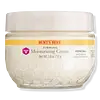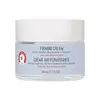What's inside
What's inside
 Key Ingredients
Key Ingredients

 Benefits
Benefits

 Concerns
Concerns

 Ingredients Side-by-side
Ingredients Side-by-side

Water
Skin ConditioningDecyl Cocoate
EmollientHelianthus Annuus Seed Oil
EmollientGlycerin
HumectantCaprylic/Capric Triglyceride
MaskingCetyl Alcohol
EmollientBakuchiol
AntimicrobialBeeswax
Emulsion StabilisingGlyceryl Stearate Citrate
EmollientStearic Acid
CleansingStearyl Alcohol
EmollientZea Mays Starch
AbsorbentTocopherol
AntioxidantGlycine Soja Oil
EmollientCetearyl Alcohol
EmollientCoco-Glucoside
CleansingMagnesium Aluminum Silicate
AbsorbentXanthan Gum
EmulsifyingSodium Stearoyl Lactylate
EmulsifyingArginine
MaskingSclerotium Gum
Emulsion StabilisingParfum
MaskingPhenoxyethanol
PreservativeEugenol
PerfumingGeraniol
PerfumingLimonene
PerfumingLinalool
PerfumingWater, Decyl Cocoate, Helianthus Annuus Seed Oil, Glycerin, Caprylic/Capric Triglyceride, Cetyl Alcohol, Bakuchiol, Beeswax, Glyceryl Stearate Citrate, Stearic Acid, Stearyl Alcohol, Zea Mays Starch, Tocopherol, Glycine Soja Oil, Cetearyl Alcohol, Coco-Glucoside, Magnesium Aluminum Silicate, Xanthan Gum, Sodium Stearoyl Lactylate, Arginine, Sclerotium Gum, Parfum, Phenoxyethanol, Eugenol, Geraniol, Limonene, Linalool
Water
Skin ConditioningStearic Acid
CleansingGlycerin
HumectantNiacinamide
SmoothingC12-15 Alkyl Benzoate
AntimicrobialCaprylic/Capric Triglyceride
MaskingGlyceryl Stearate Se
EmulsifyingGlyceryl Stearate
EmollientDimethicone
EmollientCetearyl Alcohol
EmollientPanthenol
Skin ConditioningColloidal Oatmeal
AbsorbentSoluble Collagen
HumectantPentapeptide-34 Trifluoroacetate
EmollientSqualane
EmollientChrysanthemum Parthenium Extract
Skin ConditioningGlycyrrhiza Glabra Root Extract
BleachingCamellia Sinensis Leaf Extract
AntimicrobialCeramide NP
Skin ConditioningDiamond Powder
AbrasiveButyrospermum Parkii Butter Extract
Skin ConditioningAllantoin
Skin ConditioningCaprylyl Glycol
EmollientPolymethylsilsesquioxane
Propanediol
SolventXanthan Gum
EmulsifyingPhenoxyethanol
PreservativeSodium Hydroxide
BufferingDisodium EDTA
Sodium Benzoate
MaskingTetrasodium EDTA
Water, Stearic Acid, Glycerin, Niacinamide, C12-15 Alkyl Benzoate, Caprylic/Capric Triglyceride, Glyceryl Stearate Se, Glyceryl Stearate, Dimethicone, Cetearyl Alcohol, Panthenol, Colloidal Oatmeal, Soluble Collagen, Pentapeptide-34 Trifluoroacetate, Squalane, Chrysanthemum Parthenium Extract, Glycyrrhiza Glabra Root Extract, Camellia Sinensis Leaf Extract, Ceramide NP, Diamond Powder, Butyrospermum Parkii Butter Extract, Allantoin, Caprylyl Glycol, Polymethylsilsesquioxane, Propanediol, Xanthan Gum, Phenoxyethanol, Sodium Hydroxide, Disodium EDTA, Sodium Benzoate, Tetrasodium EDTA
 Reviews
Reviews

Ingredients Explained
These ingredients are found in both products.
Ingredients higher up in an ingredient list are typically present in a larger amount.
This ingredient is an emollient, solvent, and texture enhancer. It is considered a skin-softener by helping the skin prevent moisture loss.
It helps thicken a product's formula and makes it easier to spread by dissolving clumping compounds.
Caprylic Triglyceride is made by combining glycerin with coconut oil, forming a clear liquid.
While there is an assumption Caprylic Triglyceride can clog pores due to it being derived from coconut oil, there is no research supporting this.
Learn more about Caprylic/Capric TriglycerideCetearyl alcohol is a mixture of two fatty alcohols: cetyl alcohol and stearyl alcohol. It is mainly used as an emulsifier. Emulsifiers help prevent the separation of oils and products. Due to its composition, it can also be used to thicken a product or help create foam.
Cetearyl alcohol is an emollient. Emollients help soothe and hydrate the skin by trapping moisture.
Studies show Cetearyl alcohol is non-toxic and non-irritating. The FDA allows products labeled "alcohol-free" to have fatty alcohols.
This ingredient is usually derived from plant oils such as palm, vegetable, or coconut oils. There is debate on whether this ingredient will cause acne.
Due to the fatty acid base, this ingredient may not be Malassezia folliculitis safe.
Learn more about Cetearyl AlcoholGlycerin is already naturally found in your skin. It helps moisturize and protect your skin.
A study from 2016 found glycerin to be more effective as a humectant than AHAs and hyaluronic acid.
As a humectant, it helps the skin stay hydrated by pulling moisture to your skin. The low molecular weight of glycerin allows it to pull moisture into the deeper layers of your skin.
Hydrated skin improves your skin barrier; Your skin barrier helps protect against irritants and bacteria.
Glycerin has also been found to have antimicrobial and antiviral properties. Due to these properties, glycerin is often used in wound and burn treatments.
In cosmetics, glycerin is usually derived from plants such as soybean or palm. However, it can also be sourced from animals, such as tallow or animal fat.
This ingredient is organic, colorless, odorless, and non-toxic.
Glycerin is the name for this ingredient in American English. British English uses Glycerol/Glycerine.
Learn more about GlycerinPhenoxyethanol is a preservative that has germicide, antimicrobial, and aromatic properties. Studies show that phenoxyethanol can prevent microbial growth. By itself, it has a scent that is similar to that of a rose.
It's often used in formulations along with Caprylyl Glycol to preserve the shelf life of products.
Stearic Acid is a fatty acid. It is an emollient, emulsifier, and texture enhancer.
As an emollient, stearic acid helps soften skin. It aids the skin's protective barrier by preventing water loss. It also provides a gentle cleansing effect without stripping away natural oils.
Stearic acid may also be used to enhance the texture of products. It can add volume and stabilize ingredients such as water and oil. This can help water and oil ingredients from separating.
Sources of stearic acid include animal or vegetable fats/oils such as coconut or shea. It can be naturally found in butter, cocoa butter, shea butter, vegetable fats, and animal tallow.
This ingredient may not be Malassezia folliculitis, or fungal-acne safe.
Learn more about Stearic AcidWater. It's the most common cosmetic ingredient of all. You'll usually see it at the top of ingredient lists, meaning that it makes up the largest part of the product.
So why is it so popular? Water most often acts as a solvent - this means that it helps dissolve other ingredients into the formulation.
You'll also recognize water as that liquid we all need to stay alive. If you see this, drink a glass of water. Stay hydrated!
Learn more about WaterXanthan gum is used as a stabilizer and thickener within cosmetic products. It helps give products a sticky, thick feeling - preventing them from being too runny.
On the technical side of things, xanthan gum is a polysaccharide - a combination consisting of multiple sugar molecules bonded together.
Xanthan gum is a pretty common and great ingredient. It is a natural, non-toxic, non-irritating ingredient that is also commonly used in food products.
Learn more about Xanthan Gum